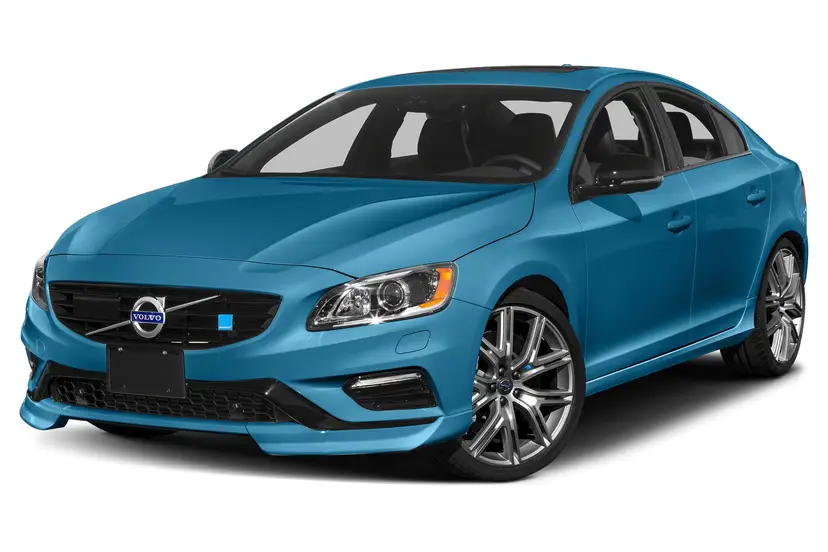
While Volvo has built a reputation for safety, the 2015 S60 succeeds because it is a powerful, agile sedan.
Volvo updated the S60’s styling last year, and the 2015 model gets a new family of drivetrains, dubbed Drive-E, that offer significantly better gas mileage and, according to Volvo, “increased driving pleasure.” To see the 2014 and 2015 S60 compared, click here.
Our T6 Drive-E test car had the more powerful of the two new engines: a 302-horsepower, 2.0-liter four-cylinder that uses a supercharger and a turbocharger. The car gets an EPA-estimated 24/35/28 mpg city/highway/combined.
The base version of the S60 starts at $34,225 including a $925 destination charge, while the T6 Drive-E starts at $39,075. Optional features raised our car’s as-tested price to $47,725.
Exterior & Styling
Volvo hasn’t made the most distinctive cars in the past, but the brand has been taking more design risks in recent years, coming out with more aggressive, unique styling. The S60 was one of the initial beneficiaries of that effort, but last year’s restyling replaced its visually interesting front-end with a new grille that’s wider but also more generic. Volvo design cues are still clearly evident from certain angles, like the rear, but there’s nothing about the new grille that’s distinctly Volvo.
How It Drives
The S60 surprised me with its nimbleness and fun personality. The light-effort power steering is direct and the car changes course quickly. It’s a setup that rewards the driver, and it’s all the more refreshing at a time when steering systems are increasingly tuned to isolate the driver from the road — even among brands, like BMW, that are known for driving performance. Other luxury automakers could learn from what Volvo is doing here.
With the T6 Drive-E powertrain, the S60 is also quick. Whether you’re driving in the city or on the highway, the four-cylinder engine feels strong and pushes the car forward rapidly when you’re liberal with the gas pedal. If you didn’t know what was under the hood, you’d probably conclude the car had a turbocharged six-cylinder.
Thank the T6 Drive-E’s unique induction technology for the four-cylinder engine’s robust, seamless power. A supercharger builds power at low engine rpm while a turbocharger spools up at higher engine speeds. Fuel-saving stop-start technology is standard, and while the Volvo’s was no worse than similar systems from other automakers, this feature annoys me, so I mostly drove with it off.
A new eight-speed automatic transmission is the other part of the Drive-E formula. It drives the front wheels, but even with the high-output four-cylinder engine I didn’t notice any torque steer. (Another editor, however, did.)
The automatic upshifts smoothly, and in higher gears engine rpm is so low you barely hear the four-cylinder. When you need more power, it’s easy to make the transmission kick down a gear by nudging the gas pedal.
Our S60 had optional 19-inch wheels and Volvo’s Sport Chassis, which includes a front strut-tower brace, 15-mm shorter front springs and monotube rear shocks. The firm suspension tuning communicates bumps large and small. The resulting ride quality is busy, but I never walked away from the S60 feeling sore. The car stays relatively flat when cornering but doesn’t feel particularly athletic, and it doesn’t urge you to go faster, like the BMW 3 Series will.
The one glaring problem with the S60 driving experience is its non-linear brake-pedal response, which is reminiscent of some gas/electric hybrids. Making a smooth stop requires extra concentration.
Interior
The S60’s interior has premium materials, and fit-and-finish is good, but it’s not very luxurious-looking; the dashboard is plain apart from a few flourishes, like a thin center control panel and an optional digital instrument panel. Our test car’s dreary gray color scheme didn’t help matters. Volvo offers black and beige interiors, too.
Front-seat comfort is good. The bucket seats are soft, but the side bolsters hold you firmly in place in fast corners. A wheel on the backrest adjusts the manual lumbar support.
The backseat is similar in size to the 3 Series’. Headroom is good, and the outboard seats are comfortable, but I could have used more legroom. The backs of the front seats are indented, which gives your knees some extra space.
Ergonomics & Electronics
Volvo’s multimedia system has a knob on the right side of the center control panel that you use to make selections, along with system-specific buttons to its left. It doesn’t take long to get the hang of things, but it’s not as intuitive as a good touch-screen system, like Chrysler’s Uconnect. Some of the S60’s on-screen menus include brief instructions for performing commands. This is helpful, but it also seems like an acknowledgement that the interface could be better.
Bluetooth streaming audio is standard. My iPhone paired easily with the car, which showed recent calls and had no trouble playing music stored on the phone. However, it didn’t download my contacts when I asked it to. Other automakers’ multimedia systems haven’t had a problem getting this information from my phone.
Cargo & Storage
Storage room up front includes door pockets that can fit smaller items, a shelf behind the center control panel, two sturdy-looking cupholders in the center console and, behind them, a deep, square-shaped storage bin.
The S60 has a standard 60/40-split folding backseat with a trunk pass-through. There’s a small ledge between the folded seats and the cargo floor, but Volvo accounts for it with a built-in ramp in the trunk floor. Most automakers don’t. The floor can also have a flip-up divider with a strap for holding grocery bags or other cargo.
The trunk measures 12 cubic feet, which is slightly smaller than what the Audi A4 (12.4), Infiniti Q50 (13.5) and BMW 328i (13) offer. (To see these cars’ specs compared, click here.)
Safety
The 2015 S60 received a five-star overall crash-test rating from the National Highway Traffic Safety Administration. The 2014 version of the car received a Top Safety Pick Plus designation from the Insurance Institute for Highway Safety and the 2015 model will also get this rating.
The S60 comes standard with City Safety, a system designed to prevent or lessen the severity of a low-speed collision with a car in front of you. Depending on the S60’s closing speed, the system can ready the brakes or automatically brake the car. A backup camera is optional.
A number of advanced safety features are bundled in two packages. The $900 Blind Spot Information System Package includes a blind spot warning system, rear cross-traffic alert, and front and rear parking sensors. The $1,500 Technology Package adds adaptive cruise control, collision warning with automatic braking, pedestrian and cyclist detection with automatic braking, lane departure warning and automatic high-beam headlights.
You’re constantly aware of these safety systems when driving in urban traffic. You’ll see the door-mounted light for the blind spot warning system out of the corner of your eye as cars approach, and the dashboard-mounted collision warning light glows dimly when you’re following another car closely.
Our past experience with Volvo’s automatic-braking systems hasn’t been great; the gates at the parking garage where we park our test cars consistently triggered automatic braking in two previous S60 model years. I didn’t experience that with the 2015 version, but two of our editors did. I inched slowly toward the gate when entering and leaving the garage, however.
For a full list of safety features, check out the Features & Specs page. To see how well child-safety seats fit in the S60, see our Car Seat Check.
Value in Its Class
If you’ve priced out a luxury car lately, one of the things you’ve probably noticed is how fast the price rises when you start checking the boxes for optional features. The S60 isn’t immune to this phenomenon, but its as-tested price of $47,725 gets you a car that’s very well-equipped and costs thousands of dollars less than a similarly configured Q50 or 3 Series. Volvo might not have the cachet of a BMW, but it feels like you get a lot for your money with this car. That’s the kind of distinction I’ll readily embrace.







































